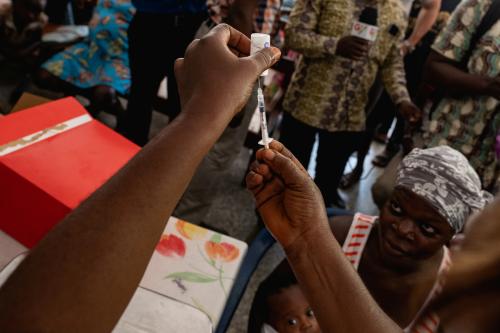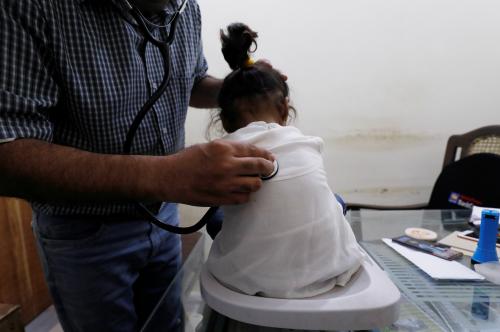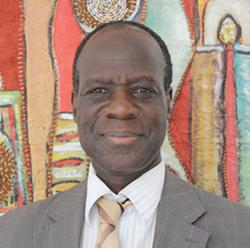Health systems in most low- and middle-income countries face two major obstacles: insufficient domestic funding and inefficient use of available resources. While the problem of insufficient domestic funding has partly been mitigated by foreign aid, these arrangements are changing quickly: As countries move from low- to middle-income status, they are perceived as capable of financing their health systems. Some donors have begun to transition out of such middle-income countries. While graduation from foreign aid is a positive milestone for any country, this transition, if poorly managed, may lead to a reversal of health gains. The suspicion is that this is happening in many countries.
To better understand if a country is likely to be able to weather such a transition from aid, we analyzed just how “dependent” a near-transition country, Kenya—classified as a lower-middle-income country since 2014—is using two concepts: donor dependency and donor concentration.
- Donor dependency measures the extent to which a country could absorb the shock of a donor funding decline or exit. Given that the domestic government would be the primary party responsible for covering funding gaps left by donors, we focus on external and domestic government resources only. We consider ratios of external resources to domestic public resources above 0.25 (i.e., 1:4) as “dependent.” In other words, we argue that it would be difficult for a government to fill a gap of 25 cents or greater for every dollar it currently spends.
- A concentrated donor environment creates vulnerabilities. If very few stakeholders contribute the majority of funds to a pool of external resources, then any change in an individual donor’s funding level or behavior could have a large impact on external resources available for a particular sector or sub-sector. Donor concentration also weakens a country’s ability to negotiate better terms for the aid it receives. We use the following threshold for donor concentration: when less than 20 percent of donors make up more than 50 percent of official development assistance (ODA). More details on our methodological approach and data sources can be found in our working paper.
What we found
Kenya is facing both donor dependency and donor concentration in its health system.
- Kenya faces substantial, albeit declining, donor dependency across its health sector. From 2001-2016, donor spending was at least 50 percent greater than domestic government expenditures for health. In some years (e.g., 2005-2006 and 2009-2010) donors spent double the amount spent by the government of Kenya on health.
- Kenya faces serious donor dependency in several key subsectors of its health system. External financing makes up more than half of all funding for immunizations, tuberculosis (TB), and HIV, where for every dollar spent by the Kenyan government on immunizations, TB, and HIV, donors spend 3.3, 2.8, and 1.7 additional dollars respectively.
- Kenya has a concentrated donor landscape. In 2017, four donors made up nearly 90 percent of all health ODA: the United States (62 percent), the Global Fund to Fight AIDS, Tuberculosis and Malaria (18 percent), the United Kingdom (5 percent), and Gavi (4 percent).
- Each of the top five recipient subsectors for health ODA face donor concentration. In 2017, one donor made up 84 percent of all ODA for the control of sexually transmitted diseases—including HIV/AIDS (the United States), two donors made up 99 percent of malaria ODA (the Global Fund to Fight AIDS, Tuberculosis and Malaria and the United States), two donors made up 86 percent of basic health care ODA (Gavi—The Vaccine Alliance and the International Development Association), three donors made up 85 percent of health policy and administration ODA (Japan, Denmark, and Germany), and three donors made up 85 percent of reproductive health ODA (Germany, the U.K. and the U.S.).
- Kenya’s HIV program is particularly donor dependent and concentrated. The majority of Kenya’s health ODA targets STD control, including HIV/AIDS, a pattern that has held for nearly two decades. Kenya’s HIV program is characterized by high, albeit declining, donor dependency: As of 2017, for every dollar spent by the domestic government, donors contributed 2.2 times that amount to HIV prevention and control in Kenya. Out of all financing sources, the U.S. President’s Emergency Plan for AIDS Relief (PEPFAR) is the primary funder of Kenya’s HIV response, having contributed over 50 percent of total HIV/AIDS funds and over 80 percent of all external HIV/AIDS funds every year since 2012.
What we could do
Our findings suggest several actions that can be taken to better appreciate Kenya’s current reliance on external funding and to make arrangements for its exit from aid.
- Proactively prepare for transition, even where transition is not an immediate reality. Kenya should accelerate plans to identify and manage areas of health system vulnerabilities via a domestically formulated transition readiness plan. Developing this plan is a nontrivial pursuit and will likely require resources that some might argue could be better spent elsewhere. However, if long-term sustainable financing through domestic resources is a goal worth pursuing, then developing a transition plan is a necessary next step.
- Increase domestic resources for health. Although financing alone will not resolve all transition-related concerns, ensuring adequate funds are available for all health programs is essential for meaningful progress toward universal health coverage (UHC). The major hurdle to overcome will be how best to increase domestic health spending in the face of economic challenges made worse by the COVID-19 pandemic and, more important, the increasing burden of servicing external debt (current debt-to-GDP ratio is approximately 0.7). Can stakeholders muster the political will to preserve and increase health care budgets while other sectors face potential budget cuts?
- Address health system inefficiencies. Fully replacing donor funding may not be necessary if inefficiencies were created as part of donor programs. The World Health Organization (WHO) estimates that improving efficiency in health systems could save 20 to 40 percent of current health spending. So, identifying and remedying areas of inefficiencies will help Kenya as it deals with transition in both the short and long term. Improving efficiencies requires a willingness to (a) put more emphasis on improving health care workers’ competencies and skillsets rather than health worker numbers, (b) modify programs that are not working optimally, permanently stop practices/programs that no longer work, or require closer integration of donor-funded health programs with country health systems, and (c) more integration of donor-supported programs into the health system to avoid duplication and reduce administrative costs. These decisions are not easy to make. Therefore, policymakers interested in efficiency improvements have to balance multiple priorities beyond efficiency improvements, e.g., job losses, donor coordination, and the politics of organizational change. These problems must be addressed to make progress toward efficiency improvements.
- Improve tracking and reporting on external reliance on health aid. Existing measures of donor dependency and donor concentration are not comprehensive, and often exclude major considerations such as capital investments. So, it is difficult to assess the true extent of donor dependency and donor concentration. Furthermore, tracking progress is difficult as it requires frequent collection of high-quality data that might be difficult to achieve without necessary budgetary provisions. Therefore, in addition to formally adopting global financial tracking practices (e.g., WHO system of health accounts), there should be dedicated funding to ensure that measurement and tracking are institutionalized.
- Identify clear pathways for sustaining effective coverage. Donors should evaluate and adapt their transition planning and approaches to ensure they are helping countries meet the overarching goal of a transition from aid: maintaining effective service coverage while making progress towards UHC. In some cases, the long-term goals of sustaining effective coverage on one hand and ensuring successful transition on the other hand, might lead to opposing policy prescriptions. Both donors and in-country stakeholders should be open to exploring different options within a monitoring framework that encourages learning and adaptation.
The views expressed in this paper are entirely those of the authors. They do not necessarily represent the views of the World Bank and its affiliated organizations, or those of the Executive Directors of the World Bank or the governments they represent.
The Brookings Institution is committed to quality, independence, and impact.
We are supported by a diverse array of funders. In line with our values and policies, each Brookings publication represents the sole views of its author(s).










Commentary
Reducing Kenya’s health system dependence on donors
March 2, 2021